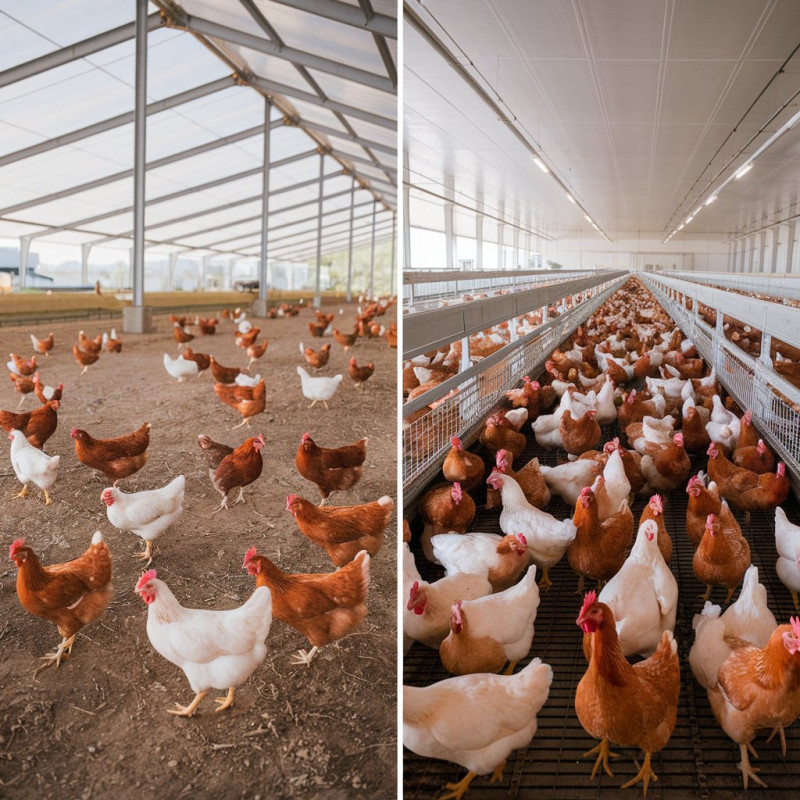Choosing Between Free-Range and Cage Systems for Poultry
Date : 2024-11-30
When it comes to poultry farming, one of the most important decisions you'll make is choosing the right housing system for your birds. The two most common systems are free-range and cage-based (or battery) systems, each with its own advantages and challenges. But which one is the best fit for your farm? This blog will explore both systems in-depth to help you make an informed decision based on animal welfare, production efficiency, and sustainability.
What Are Free-Range and Cage Systems?
Free-Range Systems allow poultry to roam freely outdoors, while still providing shelter in a coop or barn for nighttime protection. This system is designed to give birds more space and natural behaviors, such as foraging, dust-bathing, and socializing.
Cage Systems, also known as battery cages, are indoor housing systems where hens are kept in small, confined spaces, typically stacked in rows. The birds' movement is limited, and they are often unable to perform many natural behaviors, such as spreading their wings or perching.
Animal Welfare: Which System is Better?
When it comes to the well-being of your poultry, the free-range system is often considered the better option. Studies have shown that hens raised in free-range environments tend to have better mental and physical health due to the ability to express natural behaviors. They can forage for food, enjoy sunlight, and scratch in the dirt, all of which contribute to a more natural and healthier life.
On the other hand, cage systems restrict most natural behaviors. Hens are typically confined to a small space, with limited opportunities for movement. This lack of space can lead to stress, feather pecking, and health issues such as osteoporosis due to a lack of exercise and calcium absorption. Many animal welfare organizations, including the Humane Society, advocate for the phasing out of battery cages in favor of more humane systems.
Production Efficiency: How Do They Compare?
While free-range systems may be better for animal welfare, cage systems tend to be more efficient from a production standpoint. In cage systems, you can house more birds in a smaller space, which means more eggs can be produced per square foot. Battery cages are designed to maximize egg production, making them a popular choice for large-scale commercial operations that prioritize high output.
Free-range systems, however, can be more costly to maintain. The larger space required for each bird can lead to higher feed costs, as hens may spend more energy foraging outdoors. Additionally, free-range farms may have higher initial capital investment for building larger coops and fencing. But despite the higher costs, many consumers are willing to pay a premium for eggs produced in more humane and sustainable conditions, which can make free-range systems financially viable in the long run.
Sustainability and Environmental Impact
In terms of environmental impact, free-range systems generally have a lower carbon footprint compared to cage systems. Free-range farms often rely on rotational grazing, which can improve soil quality and help reduce the need for chemical fertilizers. Additionally, these systems can be more biodiversity-friendly, as they allow for a more natural environment for both the poultry and other species.
Cage systems, however, are more intensive and can result in higher waste management costs. The large concentration of birds in a small area can lead to high levels of ammonia buildup, which can be harmful to both the birds and the environment. Furthermore, cage-based operations may contribute to overuse of antibiotics, leading to concerns about antibiotic resistance.
Consumer Preferences and Market Trends
Consumer demand for ethically produced food has been on the rise in recent years, and free-range eggs are becoming increasingly popular. Shoppers are willing to pay more for eggs labeled as "free-range" or "cage-free" because they associate these terms with higher animal welfare standards. This shift in consumer preference is being driven by growing awareness of factory farming practices and their impact on both animals and the environment.
As more consumers prioritize animal welfare, many large retailers and food brands are adopting free-range or cage-free policies. For instance, major supermarket chains are increasingly offering only free-range eggs or setting timelines to transition away from cage-based systems.
Cost Considerations: Which System Is More Expensive?
While free-range systems provide a better environment for the birds, they also come with higher costs. For instance:
Initial setup costs are typically higher because free-range systems require more space, larger coops, fencing, and outdoor areas for foraging.
Ongoing costs for feeding and maintaining free-range birds can also be higher due to increased energy expenditure from outdoor activity.
Egg production efficiency may be lower in free-range systems, meaning fewer eggs per bird compared to cage systems.
On the other hand, cage systems are cheaper to set up and maintain, especially when scaled up. They allow for higher density housing, meaning more birds in less space. This can result in lower production costs per egg. However, the initial investment in building cages can still be significant, and the long-term sustainability of cage systems is increasingly questioned as animal welfare regulations tighten.
Final Thoughts: Which System is Right for You?
Choosing between free-range and cage systems depends on several factors including your farm's goals, size, budget, and values. Here are some key takeaways:
If you prioritize animal welfare and are looking to align with consumer trends demanding more humane farming practices, a free-range system may be the best choice.
If you are focused on production efficiency and cost-effectiveness, cage systems may be more appealing, especially for large-scale operations.
If sustainability and environmental impact are important to you, free-range systems tend to offer better outcomes in the long term.
Ultimately, the choice comes down to balancing the ethical considerations, economic factors, and the vision you have for your farm. Both systems have their place in the poultry industry, but consumer trends and animal welfare concerns are making free-range systems increasingly popular—and sometimes even necessary—for the future of poultry farming.